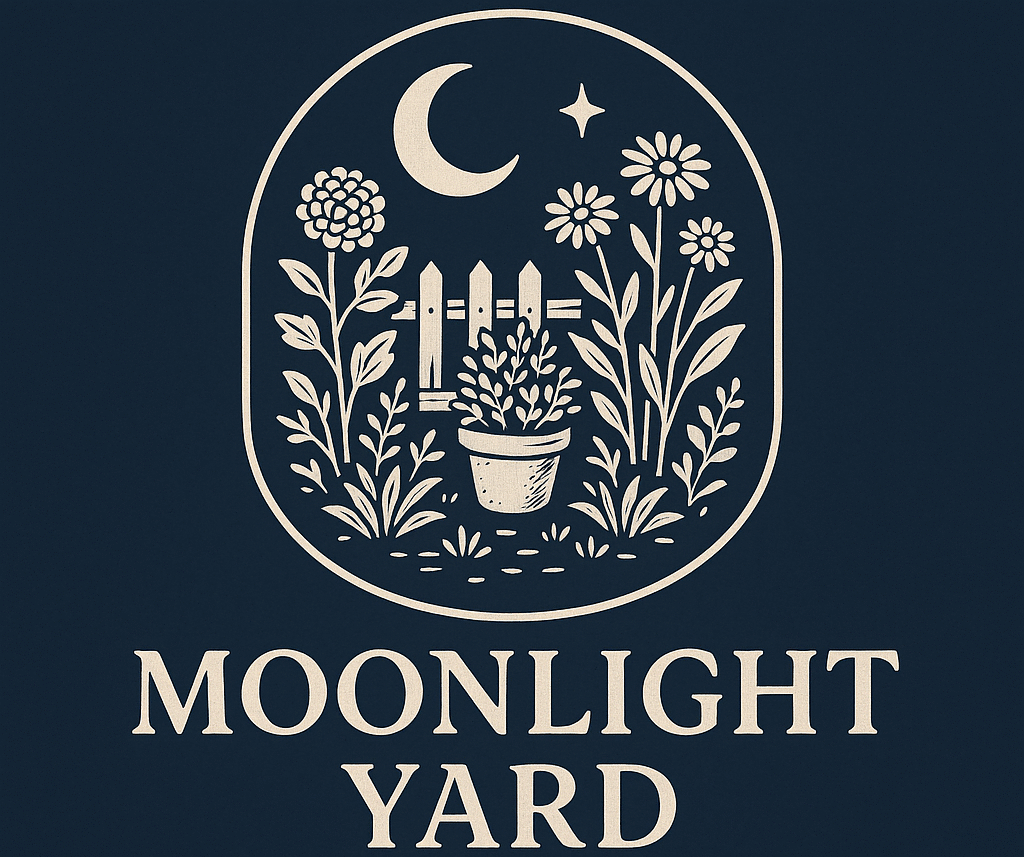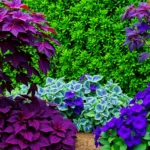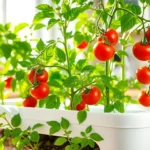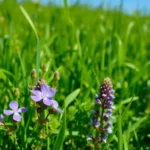We’ve all dreamed of having a stunning front garden that welcomes guests and boosts our home’s curb appeal. But let’s be honest – maintaining a picture-perfect industry can feel overwhelming when we’re juggling busy schedules and endless responsibilities.
The good news? Creating a beautiful front garden doesn’t require weekend slavery or a green thumb. With smart plant choices and strategic design decisions we can transform our outdoor space into something spectacular while keeping maintenance to an absolute minimum.
Whether we’re dealing with challenging soil conditions limited time or simply want to enjoy our weekends without constant weeding and watering there are countless ways to achieve that magazine-worthy look. From drought-resistant perennials to clever hardscaping answers we’ll explore practical ideas that deliver maximum impact with minimal effort.
Choose Drought-Tolerant Plants for Year-Round Appeal
Building on the foundation of smart design choices, we’ll focus on selecting plants that naturally require less water and maintenance. These resilient varieties form the backbone of any successful low maintenance front garden.
Native Perennials That Thrive in Your Climate
Native perennials offer the perfect combination of beauty and practicality for our front garden goals. These plants have adapted to local rainfall patterns and soil conditions over thousands of years, making them incredibly resilient once established.
Purple Coneflower blooms from summer through fall with vibrant pink petals that attract butterflies and birds. We recommend planting 3-5 plants in clusters for maximum visual impact while requiring watering only during severe drought conditions.
Black-Eyed Susan produces cheerful yellow flowers that continue blooming for months with virtually no care. This hardy perennial spreads naturally to fill empty spaces, reducing our weeding tasks significantly.
Sedum varieties like Autumn Joy store water in their thick leaves, making them perfect for sunny spots that receive minimal irrigation. Their late season blooms provide color when most other plants are fading.
Catmint creates soft purple spikes throughout the growing season while naturally repelling pests and deer. We find this perennial particularly valuable because it requires cutting back just once per year.
Ornamental Grasses for Texture and Movement
Ornamental grasses bring ever-changing movement and year round interest to our front garden design. These low maintenance plants provide structure during winter months when other plants have died back.
Fountain Grass creates graceful arching forms that sway beautifully in breezes while requiring no supplemental watering after the first year. We suggest planting these grasses in odd numbered groups of 3 or 5 for natural looking arrangements.
Blue Fescue forms compact silvery blue mounds that maintain their color throughout all seasons. This drought tolerant grass works exceptionally well as border edging or mass plantings in challenging dry areas.
Feather Reed Grass grows in narrow upright columns that won’t spread aggressively like some ornamental varieties. Its wheat colored plumes persist through winter, providing visual interest when snow covers other garden areas.
Little Bluestem displays stunning orange and red fall colors before turning golden tan for winter display. We appreciate how this native grass self seeds moderately, filling in bare spots without becoming invasive.
Evergreen Shrubs for Consistent Structure
Evergreen shrubs provide the permanent framework that gives our front garden year round appeal and structure. These reliable plants maintain their foliage through all seasons while requiring minimal pruning or care.
Barberry varieties offer colorful foliage options from deep red to bright yellow while developing thorns that naturally deter unwanted visitors. We recommend spacing these shrubs 3-4 feet apart to allow for their mature spread of 4-6 feet.
Juniper cultivars come in spreading, upright, and columnar forms to suit different design needs while tolerating extreme drought conditions. These versatile evergreens require pruning only to maintain desired shape, typically once per year.
Boxwood creates classic formal hedges or individual specimen plants that respond well to shaping while growing slowly enough to minimize maintenance. We find dwarf varieties particularly useful for foundation plantings that won’t outgrow their designated spaces.
Yew shrubs adapt to both full sun and partial shade conditions while maintaining dense evergreen foliage year round. Their slow growth rate means we can plant them close to walkways and foundations without worrying about future overcrowding issues.
Create Defined Pathways With Durable Materials
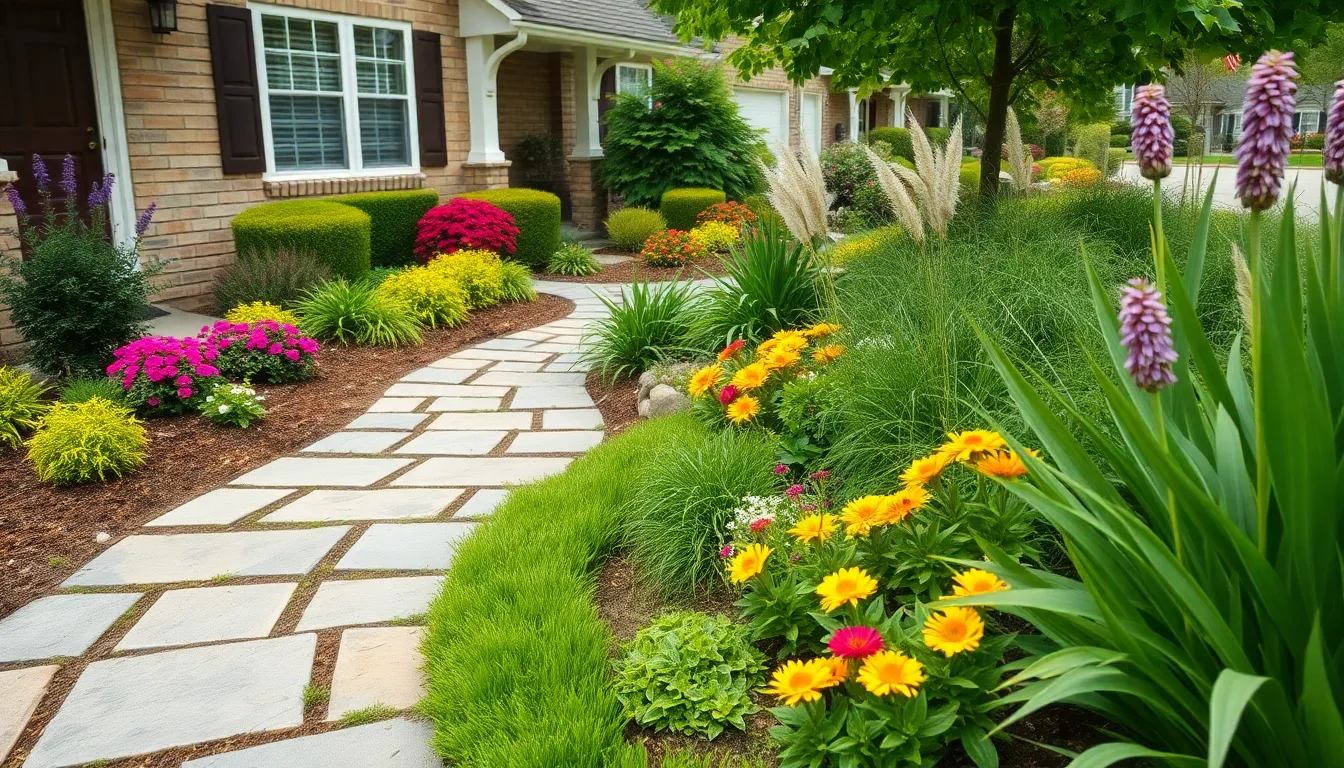
Well-designed pathways serve as the backbone of any low maintenance front garden. We recommend investing in durable materials that’ll stand the test of time while requiring minimal upkeep.
Natural Stone for Timeless Elegance
Natural stone pathways offer unmatched elegance and durability for your front garden entrance. We love how these materials create a sophisticated look that complements any architectural style. Flagstone, bluestone, and slate provide excellent options that naturally weather beautifully over decades.
Installation becomes straightforward when you choose irregular stone pieces. We find that fitting stones together like a puzzle creates visual interest while allowing for natural drainage between joints. These pathways require virtually no maintenance beyond occasional sweeping and rare joint sand replacement.
Weather resistance makes natural stone an exceptional long term investment. We’ve observed that properly installed stone walkways withstand freeze thaw cycles, heavy foot traffic, and seasonal changes without cracking or shifting like concrete alternatives.
Gravel and Decomposed Granite Options
Gravel pathways deliver outstanding low maintenance performance while reducing weed growth significantly. We recommend using crushed stone or pea gravel for walkways that naturally suppress unwanted vegetation. These materials eliminate the need for fertilizers and create permeable surfaces that handle rainfall effectively.
Decomposed granite provides a refined alternative that compacts beautifully underfoot. We prefer this option for formal front gardens because it creates smooth, stable walking surfaces. Installation involves spreading the material and compacting it with water, resulting in a pathway that looks professionally finished.
Cost effectiveness makes gravel options particularly attractive for larger pathway projects. We calculate that gravel installations typically cost 60-70% less than traditional paving materials while delivering superior drainage and weed control benefits.
Permeable Pavers for Easy Installation
Permeable pavers combine the appearance of traditional hardscaping with superior water management capabilities. We appreciate how these systems allow rainwater to pass through the surface, reducing runoff and eliminating puddle formation on your pathways.
Installation simplicity makes permeable pavers ideal for DIY enthusiasts. We find that most homeowners can complete small pathway projects over a weekend using basic tools and following manufacturer guidelines. The interlocking design ensures proper alignment and spacing automatically.
Maintenance requirements stay minimal throughout the lifespan of permeable paver systems. We recommend occasional power washing to clear debris from the permeable joints, but these pathways typically require less attention than traditional solid paving surfaces.
Install Mulch Beds to Suppress Weeds
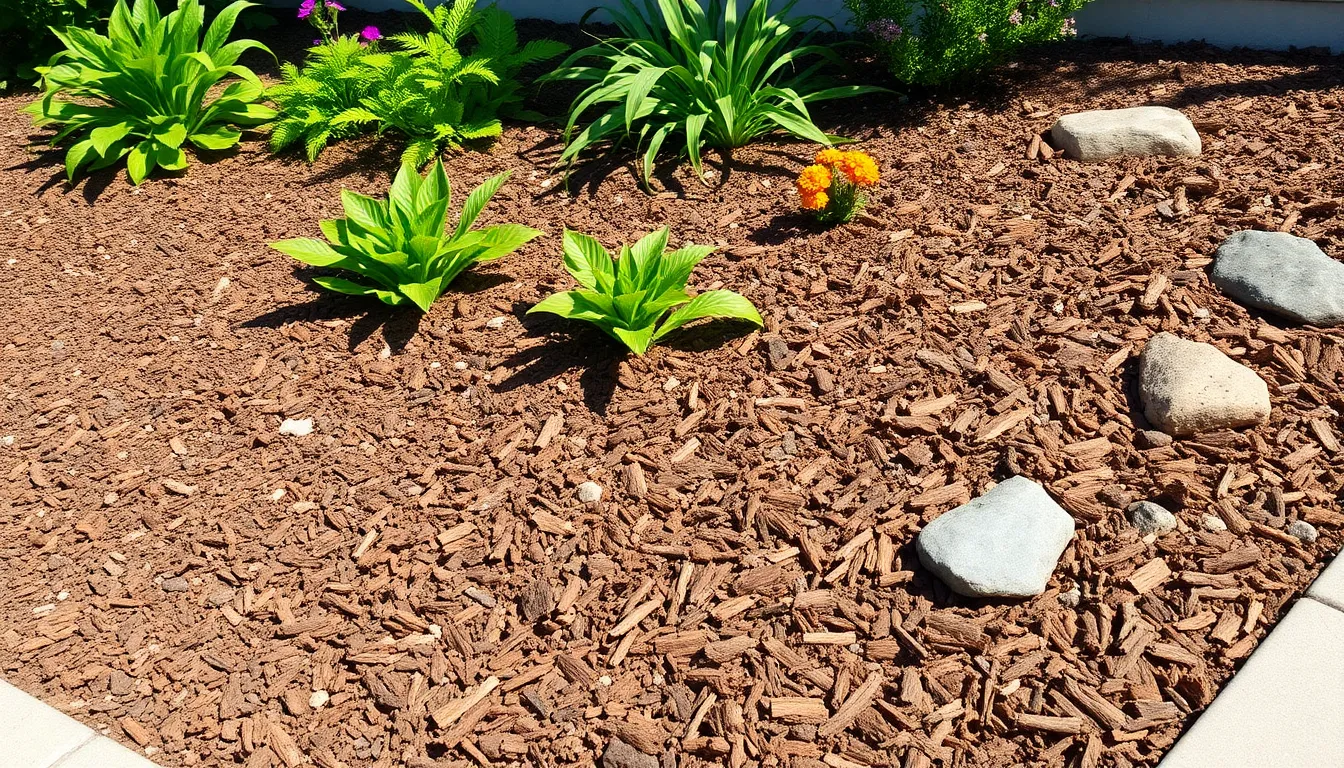
Mulch beds form the foundation of weed control in low maintenance front gardens by blocking sunlight and preventing weed seeds from germinating. These protective layers also retain soil moisture and regulate temperature, making them essential for reducing garden care tasks.
Organic Mulch Types and Benefits
Shredded bark offers long lasting coverage that decomposes slowly while enriching your soil with nutrients. Wood chips provide excellent weed suppression and gradually improve soil structure as beneficial organisms break them down. Straw creates an effective barrier that’s particularly useful around vegetable gardens and flower beds.
Composted leaves deliver dual benefits by suppressing weeds and feeding the soil as they decompose naturally. These organic options enhance water retention significantly, reducing your irrigation needs by up to 50%. Soil erosion decreases dramatically when organic mulches protect the surface from heavy rainfall and wind.
Temperature fluctuations moderate as organic mulches insulate plant roots from extreme heat and cold. Your plants experience less stress throughout the growing season when protected by these natural barriers.
Inorganic Ground Cover Alternatives
Gravel excels in dry climates where water conservation is crucial, requiring no irrigation or fertilizer applications. River rocks add decorative appeal while providing similar low maintenance benefits to traditional gravel options. Both materials significantly reduce upkeep compared to traditional grass lawns.
Artificial turf mimics natural grass appearance without mowing, fertilizing, or watering requirements. Water conservation becomes effortless when you replace high maintenance lawn areas with synthetic alternatives. Installation costs offset quickly through reduced utility bills and eliminated lawn care expenses.
Decorative stone comes in various colors and sizes, allowing creative design flexibility while maintaining practical weed control. These permanent answers require only occasional debris removal rather than annual replacement.
Proper Mulching Techniques for Maximum Effect
Apply mulch in 2 to 4 inch layers evenly across your garden beds for optimal weed suppression and moisture retention. Avoid direct contact with plant stems and tree trunks to prevent rot and pest issues that can damage your plants.
Keep mulch level rather than mounded around plants to ensure proper air circulation and water penetration. Organic mulches need replenishment as they decompose, typically requiring annual refreshing for maximum effectiveness.
Inorganic mulches require only occasional debris removal and repositioning after heavy weather events. These materials maintain their appearance and function for years without important maintenance input from you.
Design Strategic Hardscaping Elements

Hardscaping transforms your front garden into a durable, attractive space that requires minimal ongoing care. We’ll explore three key hardscaping approaches that deliver maximum visual impact with minimum maintenance demands.
Low-Maintenance Retaining Walls
Retaining walls constructed from concrete or natural stone create structural interest while managing sloping terrain effectively. These durable materials withstand weather conditions and require virtually no maintenance beyond occasional cleaning. Concrete blocks offer clean lines and modern appeal, while natural stone provides rustic charm that complements traditional home styles.
Strategic placement of these walls helps prevent soil erosion and creates defined planting areas. We recommend incorporating mulch or ground cover plants around wall bases to further reduce upkeep requirements. Stone veneer options provide natural aesthetics without the weight and cost of solid stone construction.
Installation costs vary, but the long term savings in maintenance make retaining walls a smart investment. Professional installation ensures proper drainage and structural integrity for decades of trouble free performance.
Decorative Rock Gardens and Boulders
Gravel and river rock gardens eliminate the need for fertilizers, constant watering, or exact sun exposure requirements. These materials create stunning focal points while requiring only periodic debris removal to maintain their appearance. Boulder placement adds natural character and helps anchor the overall design aesthetic.
River rocks in various sizes create texture and visual interest throughout the garden space. Gravel pathways connect different garden areas while providing excellent drainage during heavy rainfall. Decorative stones work particularly well around tree bases and in areas where grass struggles to grow.
Maintenance involves occasional raking to redistribute materials and removing fallen leaves or debris. Weather resistant properties mean these features look great year round without seasonal care requirements.
Modern Concrete Features for Clean Lines
Concrete driveways, walkways, and decorative elements provide sleek, contemporary aesthetics that require minimal upkeep compared to traditional lawn areas. These durable surfaces resist weathering and maintain their appearance for decades with basic cleaning. Clean geometric lines create visual appeal that complements modern architectural styles.
Stamped concrete options mimic natural materials like stone or brick while offering superior durability. Colored concrete adds personality without sacrificing the low maintenance benefits that make hardscaping so attractive. Expansion joints prevent cracking and ensure long lasting performance.
Minimal plantings around concrete features soften harsh edges while maintaining the low maintenance philosophy. Strategic lighting highlights these features during evening hours, extending their visual impact throughout the day.
Implement Smart Irrigation Systems
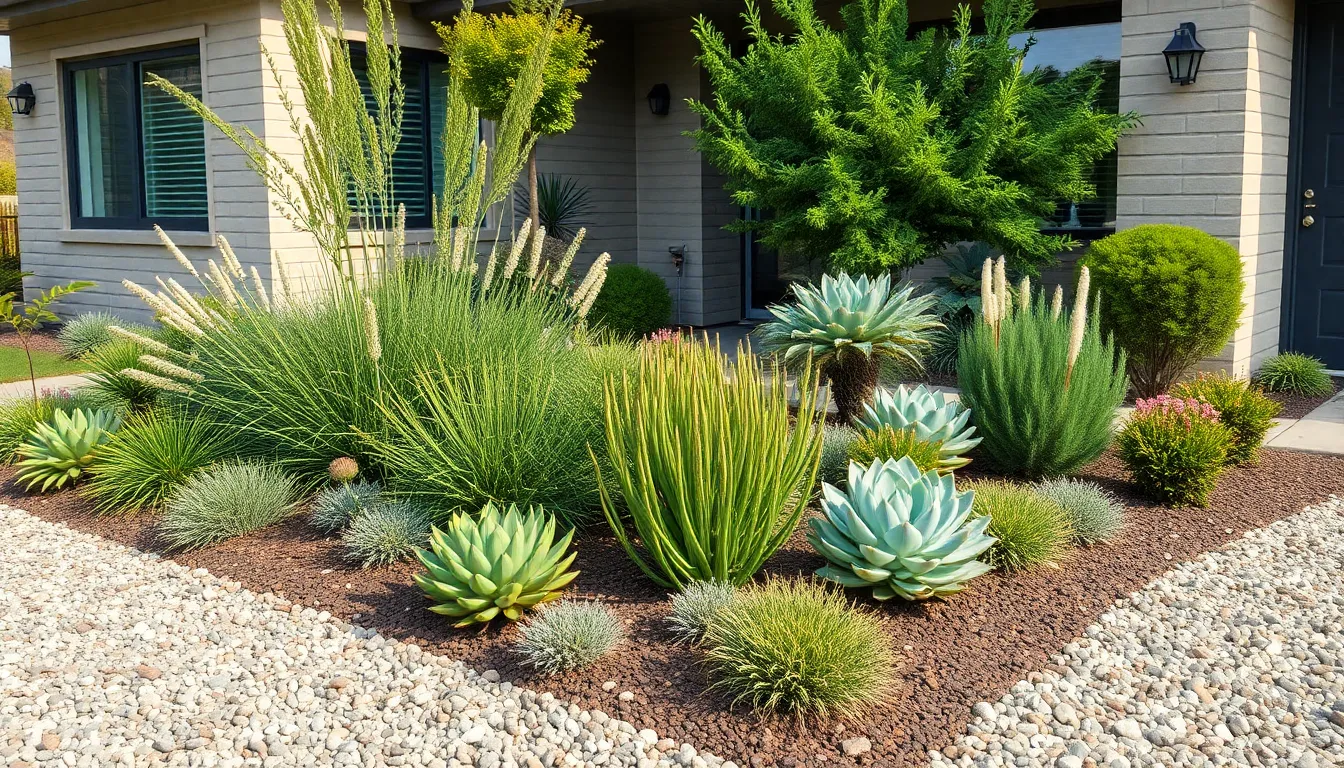
Water management becomes effortless when we integrate intelligent irrigation technology into our front garden design. These automated systems eliminate guesswork while ensuring our plants receive precisely the right amount of water.
Drip Irrigation for Targeted Watering
Drip irrigation systems deliver water directly to plant roots through a network of tubes and emitters, reducing water waste by up to 50% compared to traditional sprinklers. We can customize these systems to target exact areas of our front garden, ensuring each plant receives the exact moisture it needs. Installing drip lines around our drought-tolerant perennials and evergreen shrubs maximizes water efficiency while minimizing runoff.
The targeted approach prevents overwatering of established plants and reduces weed growth in surrounding areas. We’ll find that maintenance drops significantly since consistent moisture levels keep our chosen plants healthier with less intervention. Setting up zones allows us to water different plant types on separate schedules, accommodating varying water requirements across our garden.
Rain Sensors and Timer Controls
Rain sensors automatically pause irrigation systems when natural precipitation occurs, preventing unnecessary watering and reducing our water bills by 15-20%. These devices detect moisture levels and override scheduled watering cycles, ensuring we never waste water during rainy periods. Timer controls allow us to program watering schedules based on seasonal needs and plant requirements.
Smart controllers can adjust watering duration and frequency based on local weather data and soil moisture levels. We can monitor and adjust our irrigation system remotely through smartphone apps, making garden management incredibly convenient. Advanced systems learn from weather patterns and automatically optimize watering schedules throughout the growing season.
Xeriscaping Principles for Water Conservation
Xeriscaping combines drought-tolerant plants with efficient irrigation methods to create gardens that thrive in arid conditions while requiring minimal water input. This approach works particularly well in regions with water restrictions or naturally dry climates. We select native plants and hardy succulents that naturally adapt to local rainfall patterns and soil conditions.
Grouping plants with similar water needs allows us to create irrigation zones that maximize efficiency while minimizing waste. Strategic placement of hardscaping elements like gravel pathways and rock features reduces the overall planted area requiring irrigation. The xeriscaping approach can reduce outdoor water use by 50-75% compared to traditional landscaping while maintaining an attractive, structured appearance year-round.
Select Easy-Care Flowering Plants
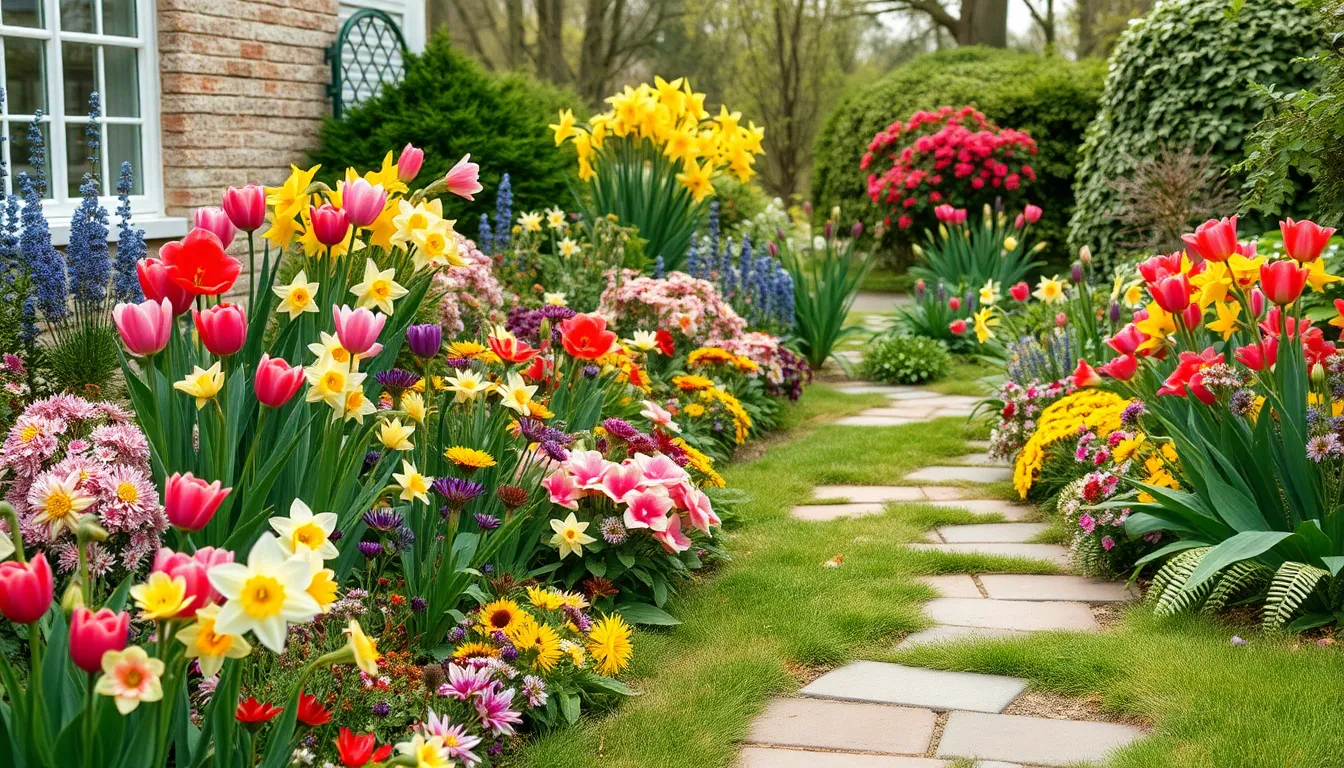
Building on our hardscaping foundation, we’ll now explore flowering plants that provide stunning color while requiring minimal maintenance. These strategic plant choices ensure our front garden stays vibrant throughout the seasons without demanding constant attention.
Bulbs That Return Each Season
Spring bulbs like tulips, daffodils, and hyacinths transform our front garden into a colorful display year after year with virtually no effort from us. These perennial powerhouses establish themselves once and continue returning each season, eliminating the need for annual replanting. Daffodils prove especially reliable since deer and rodents typically avoid them, making them perfect for busy homeowners who want guaranteed spring color.
Fall planted bulbs like crocuses create early spring excitement when most gardens still look dormant. We can plant these small treasures in clusters throughout our garden beds for natural looking drifts of color. Once established, these bulbs multiply naturally over time, creating even more impressive displays without any additional work from us.
Self-Seeding Annuals for Natural Spread
Wildflowers excel at spreading naturally throughout our garden space, reducing our need for frequent replanting while creating a cottage garden atmosphere. These hardy plants drop their seeds in fall, ensuring new plants emerge the following spring without any intervention from us. Native wildflower varieties adapt perfectly to local growing conditions and support beneficial insects like butterflies and bees.
Cosmos deserve special recognition for their ability to seed themselves while providing continuous blooms from summer through fall. These cheerful flowers thrive in poor soil conditions and actually produce more blooms when we avoid fertilizing them. Their feathery foliage and daisy like flowers create a soft, natural look that complements both formal and informal garden designs.
Long-Blooming Perennials for Extended Color
Hellebores stand out as exceptional performers that bloom from late winter through early spring, creating whimsical cottage style beauty when most other plants remain dormant. These evergreen perennials tolerate shade and poor soil while requiring virtually no maintenance once established. Their flowers persist for months rather than weeks, providing exceptional value for busy gardeners.
Red twig dogwood shrubs deliver year round interest with minimal pruning requirements, offering spring flowers, summer foliage, fall color, and striking red winter stems. These versatile plants adapt to various soil conditions and provide structural backbone to our flowering plant combinations. Flowering trees like kousa dogwood and redbud add vertical interest with beautiful spring displays that don’t create messy cleanup problems like some other flowering trees.
Incorporate Functional Storage Solutions
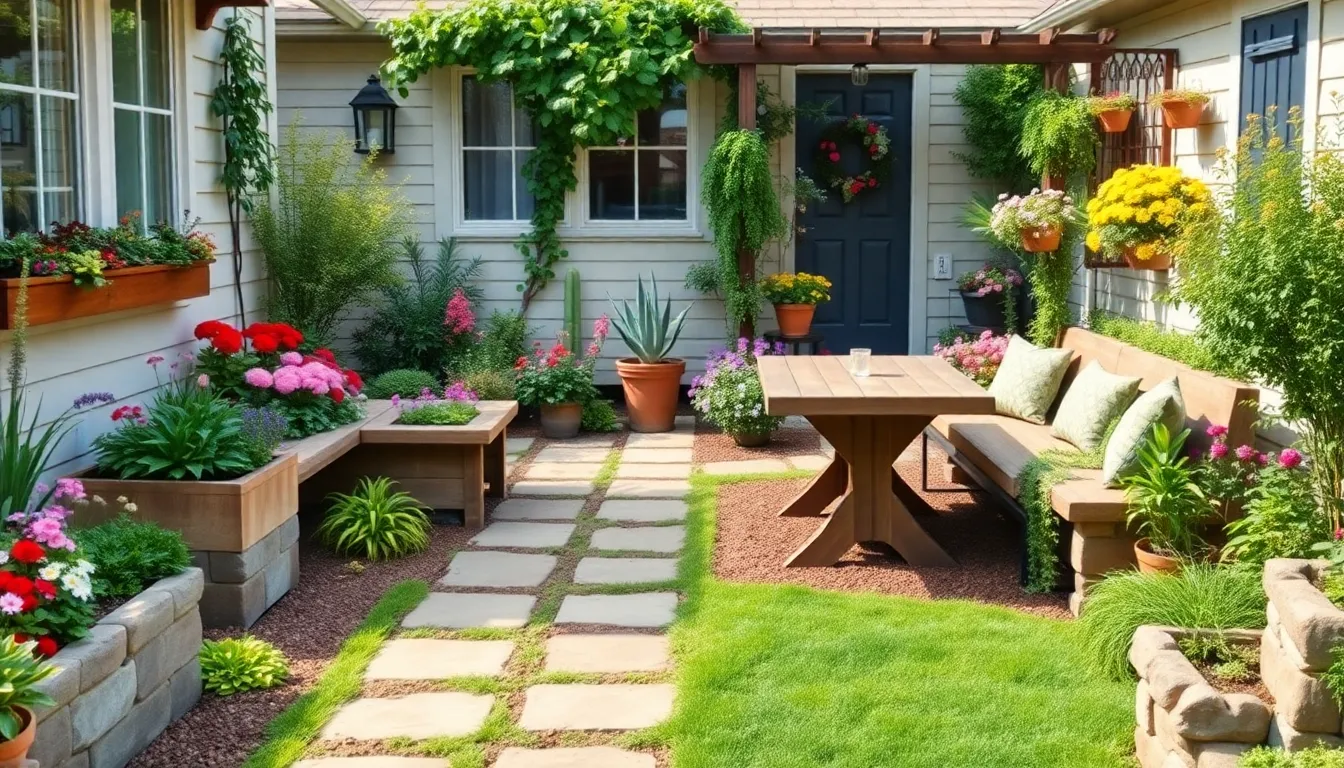
Smart storage answers transform your front garden into an organized space while maintaining its aesthetic appeal. These functional elements eliminate clutter and create purposeful design features that work double duty.
Built-In Planters That Serve Multiple Purposes
Integrated planters serve as seating or tables while housing your favorite plants. We love planters with built-in benches that provide comfortable resting spots along pathways. Wooden crates can function as both planters and informal tables for outdoor gatherings.
Square concrete planters work perfectly as makeshift tables for drinks or books. These sturdy structures support weight while containing drought-tolerant plants like succulents or ornamental grasses. Rectangular planters create natural room dividers that separate different garden zones.
Multi-tiered planters maximize vertical space without sacrificing functionality. Each level can hold different plant varieties while the lower tiers serve as display shelves. Corner planters use awkward spaces effectively while providing additional surface area for decorative elements.
Hidden Utility Areas for Garden Tools
Hidden storage keeps garden tools organized and maintains your front garden’s clean appearance. Wooden planters with built-in compartments conceal small tools like hand pruners and trowels. These decorative elements blend seamlessly with your garden design while providing practical storage.
Trellises with built-in compartments offer vertical storage answers behind climbing plants. We recommend installing shallow cabinets that disappear behind flowering vines or evergreen shrubs. These hidden areas protect tools from weather while keeping them easily accessible.
Underground storage boxes beneath decorative elements provide ample space for larger tools. Waterproof containers can be buried under garden beds and accessed through removable stone covers. Built-in cabinets that blend with industry features store seasonal equipment without visual disruption.
Integrated Seating With Plant Displays
Seating areas combined with plant displays create visually appealing focal points. Built-in planters surrounding benches frame seating areas with colorful blooms and foliage. We suggest using hanging baskets around pergolas or arbors to add vertical beauty without ground maintenance.
Stone or concrete benches incorporate planters at each end for balanced design. These permanent installations require minimal upkeep while providing year-round structure. Curved seating walls can include integrated planters that follow the same architectural lines.
Raised planter beds double as informal seating along garden borders. Wide planter edges accommodate casual seating while containing low-maintenance plants like native perennials. Modular seating systems allow flexibility in arrangement while maintaining integrated plant displays.
Plan for Seasonal Interest Without Extra Work
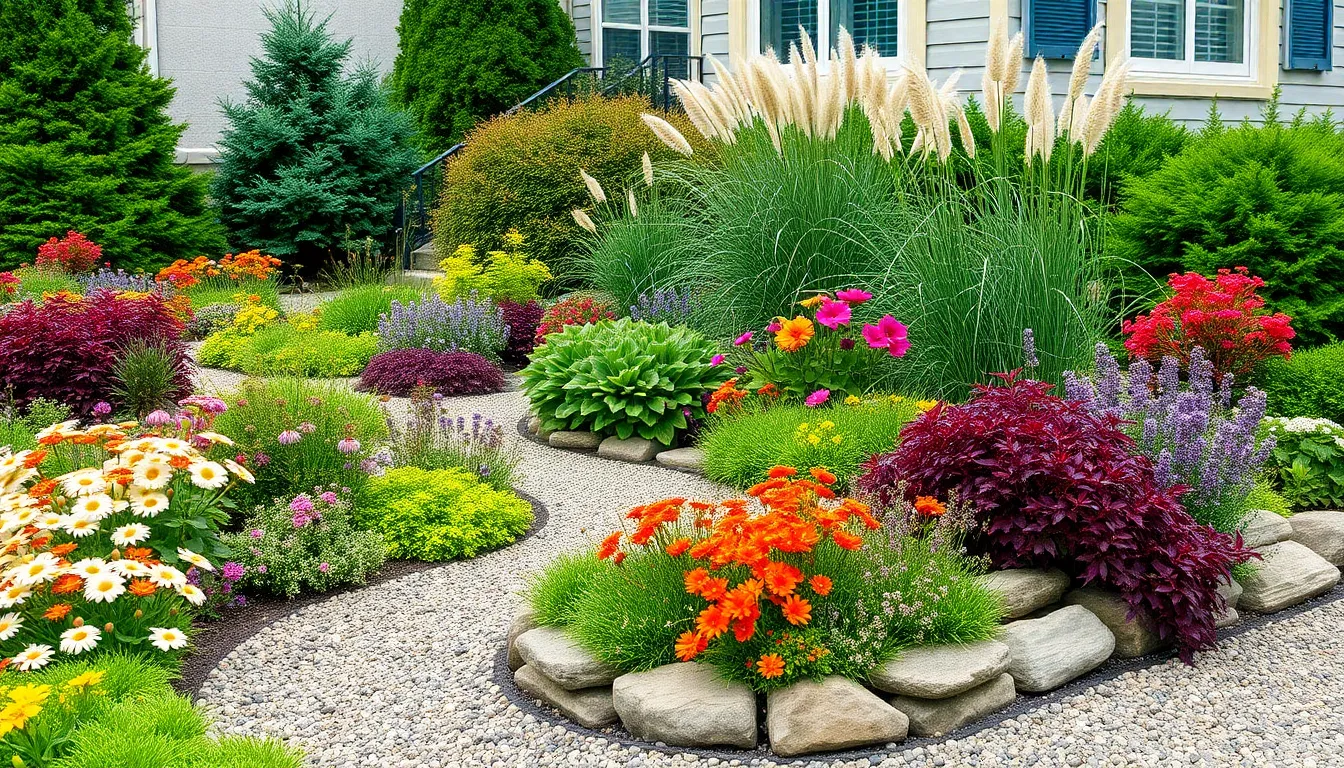
Creating a stunning front garden doesn’t mean we need to constantly replant or maintain different areas throughout the year. We can achieve year round visual appeal by selecting plants that naturally transition through seasons with minimal intervention.
Four-Season Plant Combinations
Winter foundations start with evergreen plants that provide consistent color when other plants go dormant. Hellebores bloom in late winter, offering delicate flowers just as the coldest months begin to fade. We recommend pairing these with ornamental grasses that maintain structure even after frost.
Spring awakening happens naturally when we include flowering trees like redbud alongside early perennials. Red twig dogwood provides vibrant stem color that bridges winter into spring without any pruning requirements. These combinations work together to create seamless seasonal transitions.
Summer abundance comes from strategic container plantings that we can easily swap out. Geraniums thrive in summer heat while requiring minimal watering compared to high maintenance annuals. We suggest grouping containers near entryways where their impact is maximized.
Fall finale occurs when we plant asters and sedum that naturally bloom as temperatures cool. These perennials require no special care to produce their autumn display. Kousa dogwood trees add another layer of fall interest with their distinctive fruits and colorful foliage.
Strategic Placement for Natural Growth Patterns
Cottage style layouts embrace natural growth patterns that reduce our maintenance burden significantly. We can create raised beds using natural stone to define spaces while allowing plants to grow in their preferred spreading patterns. This approach eliminates the need for constant trimming and shaping.
Slope management becomes effortless when we work with natural drainage patterns rather than against them. Plants positioned according to their water needs create micro environments that sustain themselves. We recommend placing moisture loving plants in natural low spots while positioning drought tolerant varieties on elevated areas.
Growth zone planning involves grouping plants with similar mature sizes to prevent overcrowding issues. Fast spreading ground covers can fill designated areas without encroaching on neighboring plants. We’ve found that this strategic placement reduces the need for regular division and transplanting.
Minimal Pruning Varieties for Effortless Maintenance
Native plant selections require virtually no pruning since they’ve adapted to local growing conditions over centuries. These varieties naturally maintain attractive shapes without our intervention. We can rely on native shrubs and perennials to provide structure while minimizing our workload.
Gravel garden installations eliminate traditional lawn care entirely while supporting plants that thrive in well drained conditions. Rock gardens suppress weed growth naturally and never require mowing or fertilizing. We recommend incorporating decorative stones and boulders to create focal points that need only occasional debris removal.
Self maintaining shrubs like certain juniper and barberry varieties hold their shape naturally without annual pruning. These plants provide year round structure while requiring only occasional cleanup of dead branches. Mulching around these plantings helps retain moisture and suppress weeds, further reducing our maintenance tasks.
Conclusion
Creating a stunning low-maintenance front garden doesn’t have to be overwhelming or time-consuming. We’ve shown you that with the right combination of drought-tolerant plants smart hardscaping choices and efficient irrigation systems you can achieve the curb appeal you’ve always wanted.
The key lies in making strategic decisions upfront that’ll save you countless hours later. By incorporating native perennials effective mulching techniques and automated watering systems you’re setting yourself up for long-term success with minimal ongoing effort.
Your front garden can be both beautiful and practical without demanding constant attention. Start with one or two of these ideas and gradually build your low-maintenance oasis that’ll continue to impress neighbors and visitors year after year.
Frequently Asked Questions
What are the best drought-tolerant plants for a low-maintenance front garden?
Native perennials like Purple Coneflower and Black-Eyed Susan are excellent choices as they thrive in local climates with minimal care. Ornamental grasses such as Fountain Grass and Blue Fescue add texture and movement, while evergreen shrubs like Barberry and Juniper provide consistent structure year-round. These plants enhance beauty while requiring very little upkeep.
Which pathway materials require the least maintenance for front gardens?
Natural stone offers elegance and longevity with minimal upkeep, while irregular pieces create interesting patterns and natural drainage. Gravel and decomposed granite are cost-effective options that significantly reduce weed growth. Permeable pavers are ideal for DIY installation and provide superior water management with minimal long-term maintenance requirements.
How does mulching help create a low-maintenance garden?
Mulch serves as a foundation for weed control by blocking sunlight and preventing seed germination. Organic options like shredded bark, wood chips, and composted leaves suppress weeds while retaining soil moisture and regulating temperature. Inorganic alternatives like gravel and river rocks offer low maintenance and excellent water conservation benefits.
What hardscaping elements work best for minimal garden upkeep?
Low-maintenance retaining walls made from concrete or natural stone create structural interest and prevent soil erosion. Decorative rock gardens and boulders eliminate the need for fertilizers and constant watering while providing stunning focal points. Modern concrete features like driveways and walkways offer sleek aesthetics with minimal maintenance requirements.
How can smart irrigation systems reduce garden maintenance?
Automated drip irrigation systems deliver water directly to plant roots, reducing waste and ensuring efficient moisture levels. Rain sensors and timer controls optimize watering schedules and prevent unnecessary water use. These systems work perfectly with xeriscaping principles, combining drought-tolerant plants with efficient irrigation for beautiful, low-maintenance gardens.
Which flowering plants provide color with minimal care?
Spring bulbs like tulips, daffodils, and hyacinths return each season without effort. Self-seeding annuals such as wildflowers and cosmos spread naturally, reducing replanting needs. Long-blooming perennials like hellebores and flowering trees like kousa dogwood provide extended color and minimal cleanup throughout seasons.
How can I maintain seasonal interest without constant replanting?
Select plants that naturally transition through seasons, such as evergreens for winter and flowering trees for spring. Use easy-to-swap summer container plantings and choose native plants requiring minimal pruning. Strategic placement accommodating natural growth patterns and gravel gardens that eliminate traditional lawn care ensure effortless year-round beauty.
